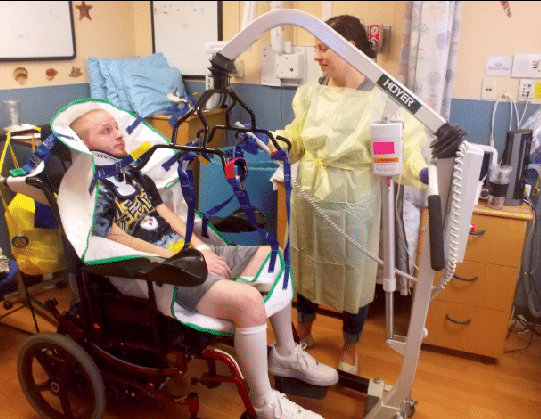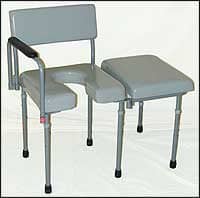by Kaitlin W. MacDonald, MOT, OTR/L
From the start of an admission, the rehabilitation team, client, and family begin thinking about discharge. This can be a daunting task for a family when a client is discharging in a wheelchair. Most homes are not wheelchair accessible and therefore many modifications must be completed. Ideally, the inpatient therapists will make a home visit or utilize pictures of the home provided by the family to make the most accurate recommendations.

From the start of an admission, the rehabilitation team, client, and family begin thinking about discharge. This can be a daunting task for a family when a client is discharging in a wheelchair. Most homes are not wheelchair accessible and therefore many modifications must be completed. Ideally, the inpatient therapists will make a home visit or utilize pictures of the home provided by the family to make the most accurate recommendations.
A Compliant Entrance
First, the team must work with the family to determine the best entrance for the client. It may be necessary for the family to purchase a permanent or temporary lift or ramp. According to the Americans with Disabilities Act (ADA):
“Ramps are preferred over transfer systems since not all children who use wheelchairs or other mobility devices may be able to use, or may choose not to use, transfer systems…Where possible, designers and operators are encouraged to provide ramps with a slope less than the 1:12 maximum.”1
The ramp must be within ADA guidelines, which often dictates which entrance can work. The landings of ramps should be “a clear landing 60 inches (1,525 mm) minimum by 60 inches (1,525 mm) minimum.”1 Additionally, there should be a level landing at the bottom and top of the ramp. The landing shall be at least as wide as the ramp, minimally 36 inches, and 60 inches in length. The ADA states that there should be handrails along both sides of the ramp.1 Once an entrance and a ramp or lift are chosen, if needed, it will be important for the client to determine an accessible space outside the home to get out of the car and access the entryway. A concrete or asphalt space is preferred to allow a wheelchair to be propelled, pushed, or powered over a hard and sturdy surface. Depending on location, a handicap personal parking spot with a curb cutout might be necessary. When a family is making these changes, it may be necessary to write a letter to the homeowners association or landlord for approval.
When choosing the entrance, it is important to consider all aspects of the entryway, such as the width of the doorway, the threshold, and the location and type of door handle. A contractor will need to take into consideration the height of the threshold to level the entryway when installing a ramp or lift. All doors in every room should be measured to ensure not only access, but usability of the client’s home to its full capacity. It is important to take into account the specific client’s width of chair to give the most accurate recommendations. The ADA recommends door widths of 32 inches at a minimum. Often therapists will provide the family with a piece of string 32 inches long (or the length of the client’s chair plus 2 inches) to measure these spaces. If doors are not wide enough, there are hinges that can replace typical hinges to increase the width of the doorway another inch or two.1 Options are available that can allow a client to access a doorway electronically. This can be costly, but can increase a client’s independence and safety as well as decrease the amount of time a caregiver is needed. Doors can be controlled with infrared devices through a power chair or an assistive technology device that is mounted on a wheelchair. Other options may include a handheld remote that the client carries or is located on the outside and inside of the doorway. There are contractors who specialize in ADA renovations who can guide families through specific, larger renovations that are needed.
Laying a Foundation for Safety
For safety and ease of wheelchair mobility within the home, it is recommended that all rooms are floored with wood or tile, with throw rugs removed and wires secured. A pathway should be cleared in living areas most often used by the client to increase independence. This can be achieved by rearranging furniture or removing unnecessary pieces, such as a coffee or end table, to allow for a greater turning radius and to maneuver through the space. The ADA recommends a turning radius of 60 inches or a 36-inch “T” space.1 If there is a specific couch or seat in which the client prefers to sit, furniture should be arranged with the transfer in mind, considering caregiver assistance as well as safety with independence. Also, table heights should be measured to make certain a person in a wheelchair can sit close to the table with legs underneath. The ADA recommends a height of 27 inches at a minimum for knee clearance.1 A client will need to utilize a table at which to eat meals or do work/homework. This is client-specific; the height of the client’s knees in the chair should be measured so the family can plan accordingly. Often clients will utilize risers to lift table heights when necessary to increase access. When recommending these changes, it is important to take a client-centered approach to know what the family values aesthetically.
The kitchen is often an area where many clients need a specific setup to be independent from a wheelchair level. It is important to determine ahead of time what items the client needs and wants to access. Anything the client wants to attain on a regular basis should be placed on shelves, countertops, or cabinets accessible from a wheelchair level. This may mean rearranging the pantry, cabinets, and refrigerator. Many microwave ovens can be moved to a table or countertop easily accessible to the wheelchair height to increase a client’s independence with meal preparation. It also may be necessary to clear the cabinet under the sink and remove those doors so the client can pull up closer to the sink with their feet in the cabinet. There are many stove adaptations as well, such as adding knobs on the front of the stove to make using the appliances easier and safer. It is important to review energy conservation techniques with the client and family to increase independence with decreased fatigue throughout the day to complete these tasks.
It is best to have a bathroom on the main floor that is accessible for a client. The main floor bathroom may have to be adapted, or part of a room may be sectioned off with a space divider or curtain to provide privacy for a commode chair. When adapting bathrooms, hand rails with screws may be necessary if the client is transferring; a contractor may need to check them as they must be screwed into specific material. Hand rails with suction cups can be problematic for a client who is putting a lot of weight on them as they are not designed to withstand an excess amount of weight. A client may need specialized durable medical equipment, such as a commode chair with a cutout. Cutouts can be customized based on the client’s or caregiver’s need to allow them access anteriorly, laterally, or posteriorly for increased independence with catheterization or a bowel program. During bathing, a shower or tub chair or bench is often necessary for safety in showers. These can be as simple as a seat with no backrest and as complex as a roll-in shower chair with a headrest, chest straps, armrests, and tilt and recline features. These items are occasionally covered by insurance with a letter of medical necessity and prescription, but the family will often have to pay out of pocket as these items are typically not deemed as medically necessary. Lastly, sinks and cabinets can be modified similar to a kitchen to allow for increased independence and decreased caregiver burden with hygienic activities.
Access at Every Level
Many families choose to make a first floor setup for the bedroom; however, if this is not possible, a stair lift may be installed for a client to reach the second floor. Likewise, once a client has passed through the home’s entry, that client may then need to access a second floor for any number of reasons. In such a case, a stair lift may need to be installed to provide access between floors. Before installation of a stair lift, typically an evaluation must be completed by a company that installs the lifts to ensure there is space at the bottom and top of the stairs that allows a client to transfer from a wheelchair onto a lift chair. Some clients, such as those with paraplegia, may be able to bump up and down stairs if a caregiver can carry the wheelchair up and down for them.
Providing optimum access within the home also may require considerations for transferring. For example, in a bedroom, some clients may need a hospital bed to increase independence with ADLs, decrease caregiver burden, and allow ease of transfers. Furniture should again be rearranged to allow open space for the wheelchair and any transfer equipment including wooden boards, beasy boards, or portable lifts. In some cases, access may boil down simply to a matter of reach. Closet hangers, for example, can often be lowered, and clothing that is used most often can be arranged in specific drawers in a dresser to allow a client to reach clothes from the wheelchair. If a client has difficulty opening drawers, a shelving unit may be recommended to increase independence in dressing.
Discharge is a team effort, with the family, to make the transition as smooth as possible. Safety is the most important factor as all other accommodations can be completed as the family and client cope and return to their previous lifestyle. It is important to remember that adaptations are client-specific. Every home and family is different; therefore, no two sets of modifications will be the same. It is important to take into account the family’s coping style, financial situation, and aesthetic preferences when making recommendations for discharge. RM
Kaitlin W. MacDonald, MOT, OTR/L, is an Occupational Therapist II at the Kennedy Krieger Institute in Baltimore. MacDonald has worked at Kennedy Krieger Institute for 3 years at the International Center for Spinal Cord Injury inpatient unit. She works with pediatric patients from infants to 21 years of age who have sustained neurological injuries related to the spinal cord. For more information, contact [email protected].
Reference
1. 2010 ADA Standards for Accessible Design. 2012.
available at: http://www.ada.gov/regs2010/2010ADAStandards/2010ADAstandards.htm
Accessed September 5, 2013.





